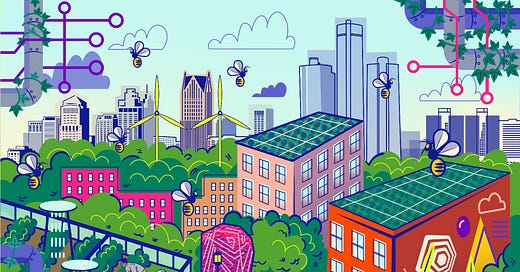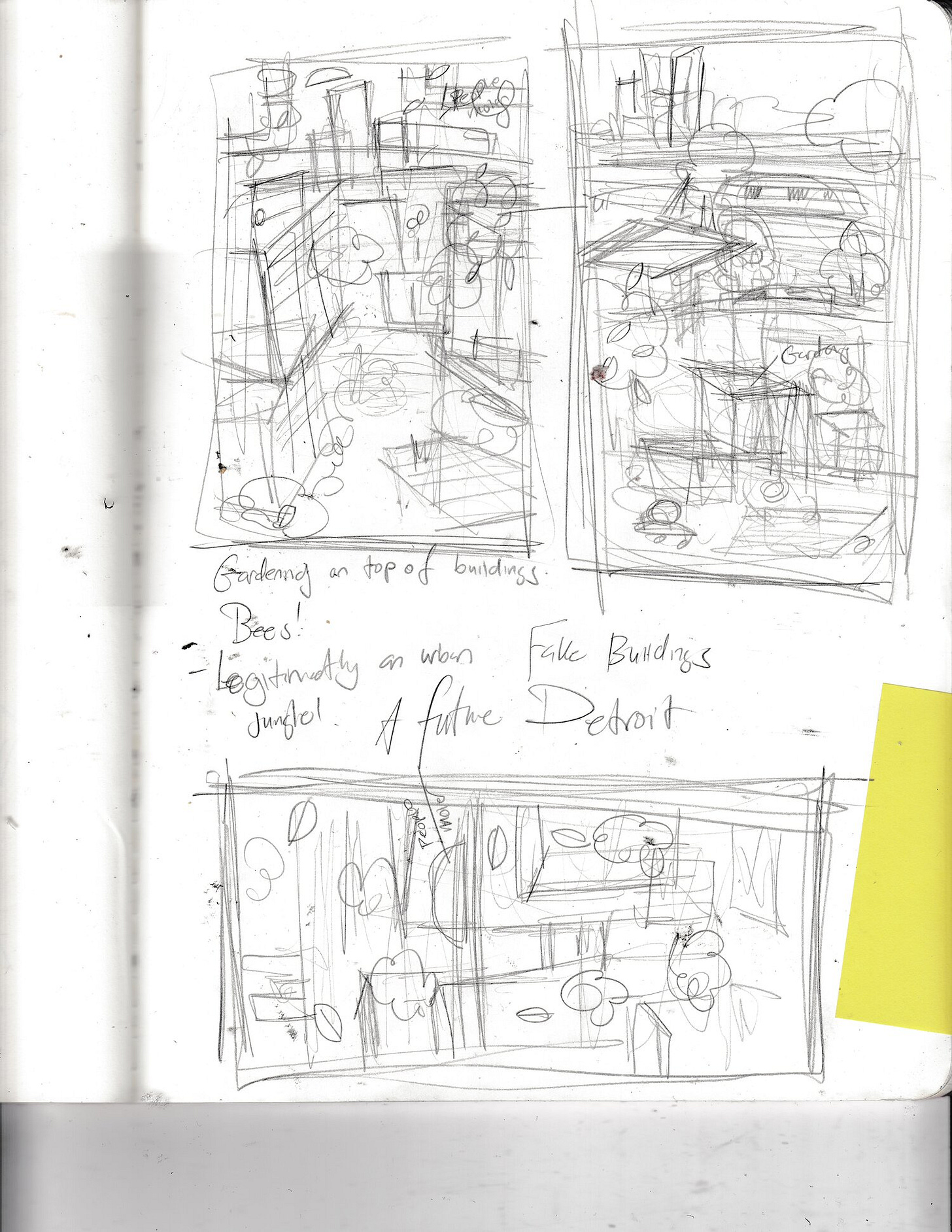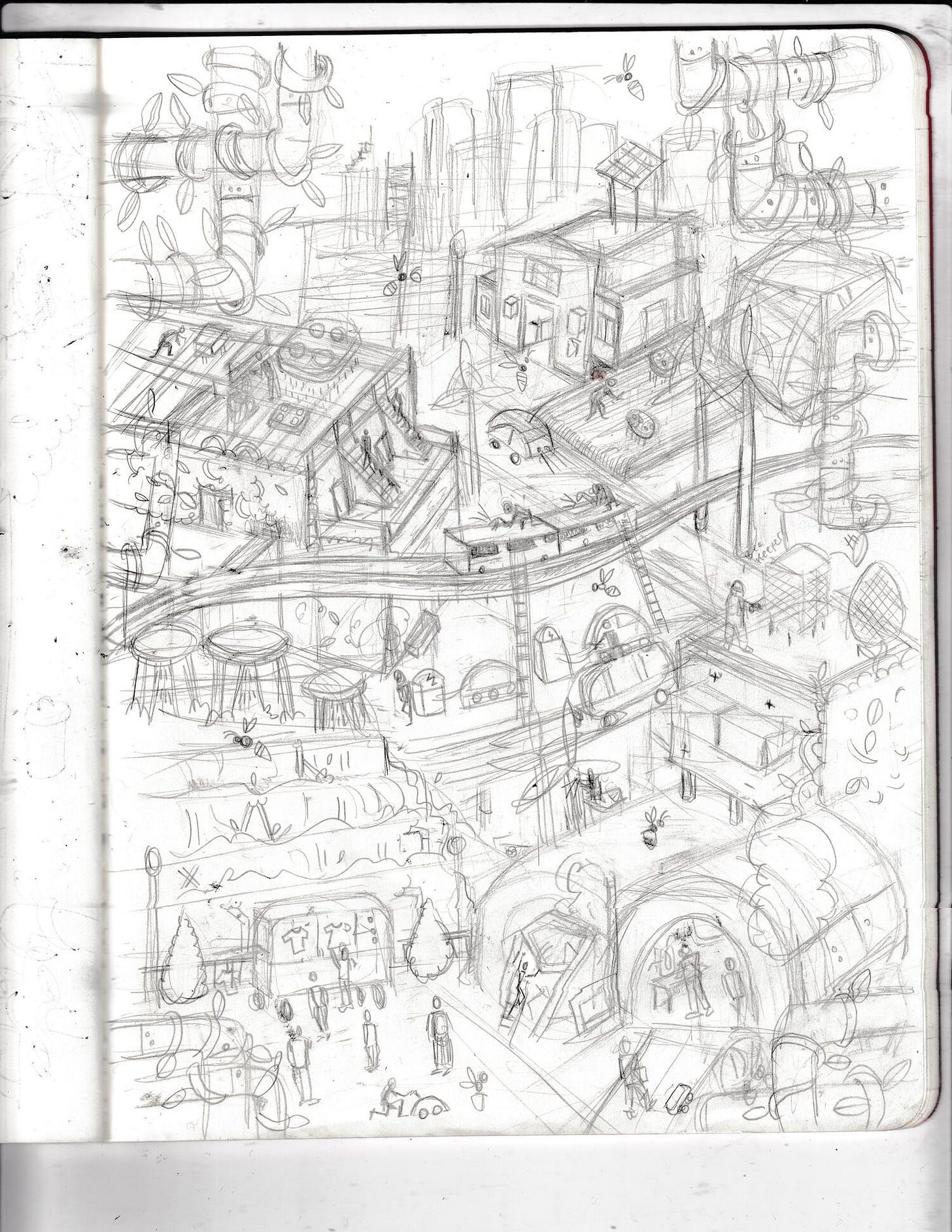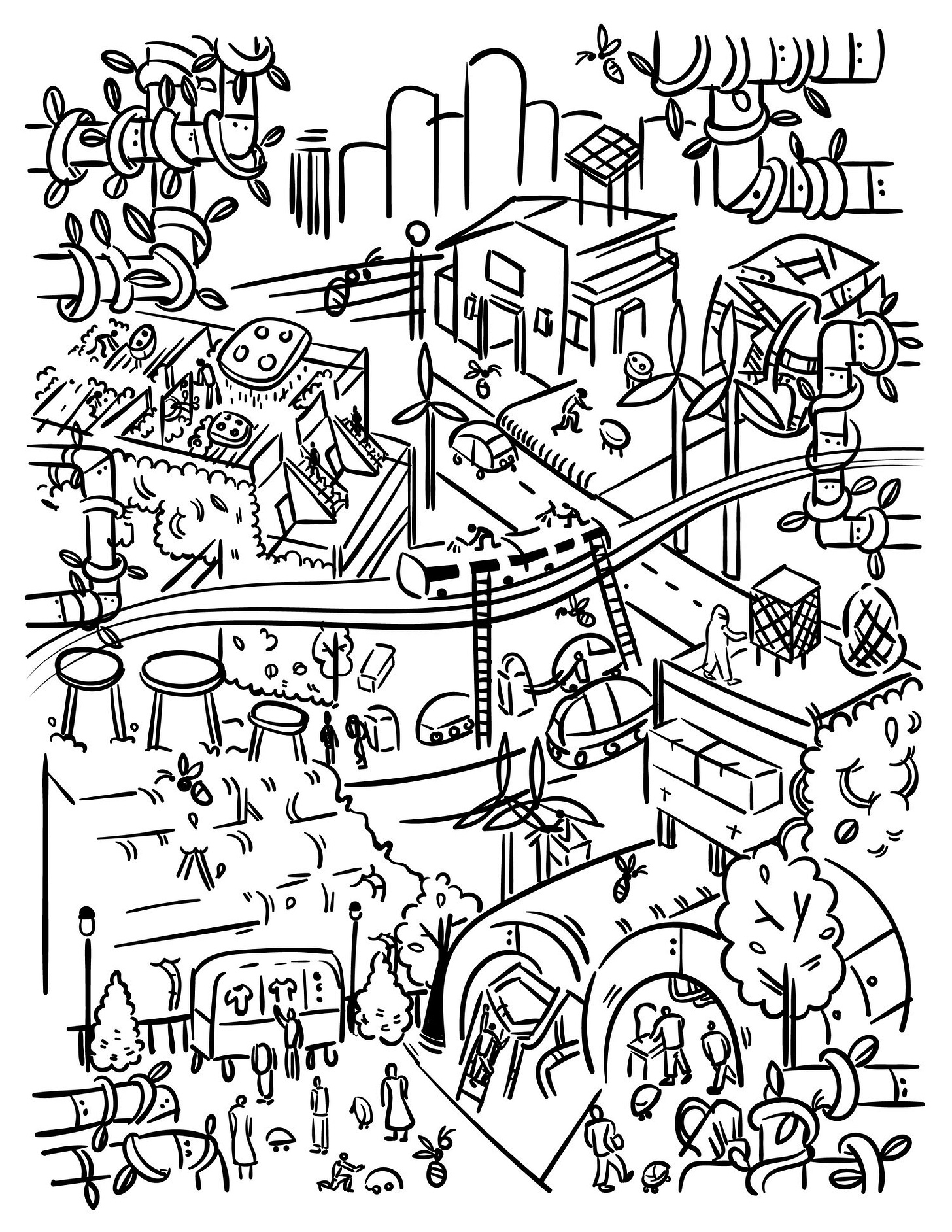Urban Technology at University of Michigan Week -32
Drawing urban technology + 3 questions for Justine Alenette Ross
Recently we’ve explored interaction design by examining the user experience of public transit, and then service design by analyzing voting in the US and tugging a little on the question of whether voting is designed or not—it’s not!
The last seven days have been a lot, and we had planned to write about strategic design in this post. What’s strategic design? It’s the act of crafting the way that things and services consciously invent or reinvent systems and structures from the inside out. Strategic designers dwell on how problems are framed so that we’re asking the right, most useful questions. They work through a design process to push for fundamental changes to the status quo. Examples and more depth on that in a forthcoming newsletter.
Today, let’s all give ourselves a minute to enjoy some really beautiful illustration work, interview the illustrator, and take a glimpse of her process.
I’m Bryan Boyer, Director of the Urban Technology degree at University of Michigan. This newsletter is about cities, technology, and design. While we launch the program, we’re detailing the process of working toward the day when we welcome our first students. Thanks for reading. Bop the button below if you know people who would enjoy this.
🖼 How can Urban Technology be Shown When so Much of it is Invisible?
The image would need to be a boisterous scene, full of people, plants, and animals cohabitating with buildings and infrastructure. Adults, children, and elderly enliven cities, right? Repairing, farming, moving, dancing, monitoring, and chatting happens in cities. Urban systems creep in around the corners, symbolized by pipes and circuitry patterns, perhaps. Things are messy and—you know what—that’s just fine. So this is how you show urban technology, or how we do anyway!
When we started thinking about how to advertise this new offering at Taubman College it proved difficult to find the right photos that we could use alongside text descriptions of the program. I mean, how do you show something that doesn’t exist yet?
If you show photos of students and faculty pondering the future of food systems, a viewer asks, “isn’t transit and a dozen other things also important to future cities?” And if you use images of transit and proliferating mobility options, then someone rightfully and inevitably asks, “but I thought urban technology is also about how those things are governed?” Yes to all of it, and this is what makes finding photos hard. They’re so singular, but the interests of our work are so multiple. We needed a more open-ended and exploratory way of bringing the degree to life with visuals: an illustration!
To help us with this, I asked Justine Allenette Ross, a Metro-Detroit based illustrator who has previously scenes around Detroit, including drawn Eastern Market, an amazing farmers market. If her name sounds familiar, that’s because we shared a hint of her progress a couple weeks ago. Justine kindly agreed to answer three questions.
✏️ 3 Questions for Justine Alenette Ross
Q. What’s your favorite city and what makes it special?
A. My favorite city is my place of birth! Detroit, Michigan. What makes Detroit special is its rich history. Detroit’s influence on popular music cannot be understated. Detroit gave America wheels. Whenever you’re in you car blasting music, Detroit did that.
Detroit has gorgeous houses and tall trees. What else is there to say? Detroit is dope. Also, I heard that the people from this area are nice. We gave you music, we gave you cars, and we’re polite to boot. What more can you ask for?
Q. What’s the oldest thing you cherish?
A. When I was eight my mother let me skip school for a day so I could spend it with my grandparents. My grandad has a painting studio in his house. He set me up in the studio and had me copy the chair in Van Gogh’s room painting, It's very much an eight year old’s interpretation of a Van Gogh, but it means a lot to me. I always keep it hanging in my room. My grandfather was always a champion of his grandkids creative endeavors. So I keep the painting as an ode to him.
Q. Justine, you’re an amazing illustrator so making up scenes and places and people all day long is your jam. If you could magically invent one thing for future cities, what would it be?
A. Firstly, thank you for the lovely compliment! And to answer your question: self building rooms. You push a button and you have a room to sleep in! When you push the button again the room gets put away. It’s portable. Ideally, you would give it to the homeless so they won’t be sleeping on the streets. It would be a temporary fix until they can own a house in their own right. And the room would be free, too! You would go to a kiosk, get a button, and have your portable room.
Editor’s note: This last answer sounds a bit like what Ori are trying to do by “choreographing motion in the home” mixed with Nightingale housing coops mixed with policy decisions that shape deeply humane housing options. We like this future, Justine, and we like your drawings and working with you!
⚙️ The Process of Creation
Since this blog is about creation (of a new degree) and creativity (of our future students) and cities, let’s celebrate Justine’s work by looking at her process. After an initial discussion and notes about potential content and vignettes for the images, she set to work on sketches. Beautiful sketches! In the earliest iterations, seen below, Justine explored various perspectives or points of view, that shape how we relate to the scene.
Over time (but very quickly) the sketches got more detailed. She had an intuition early on that the image should not have a coherent, singular perspective. If you look at the sketch below you can notice how the buildings are not all aligned on the same grid or with the same vanishing point. We’re seeing a plural city from many perspectives.
As the drawing started to get more refined, we had a number of discussions about the specifics of the technology depicted and other visual building blocks. There’s a fine line to walk. We want to be clearly thinking about the future but not so spacey that it looks unrecognizable as a city. In the sketches below, “farm help” is working better than “car” because the latter is too ambiguous. Charger (for electric vehicles) is familiar, but actually too familiar. It looks like a gas pump!
From pencil sketches in a notebook and some computer doodles, Justine jumped to a digital version. When the drawing below landed in my inbox, I knew we were on the right track.
So far so good, but there’s a house in there that looks a little too much like a McMansion (top right). And the shopping in the bottom left via a vending machine autonomous vehicle is ok but maybe not the most important focus for us. And what about that water fall just behind it? Looks cool, but the cars on the road seem to be driving into it, which is confusing. We talked it through and those conversations informed the final poster image, which you saw above in full color. Thanks to Justine for the diligent effort and hope you enjoy the poster as much as we do.
BTW - There’s no expectation that the graduates of Urban Technology will be world class illustrators, though they will most certainly be good at visual communication. Drawing is one way to being a possible urban future to life, but so are writing, coding up a simulation, building a model, cooking an evocative meal, inventing an exploratory game, and the list goes on. Design isn’t about making beautiful things, it’s about doing things thoughtfully—in 2020 that means humanely, sustainably, and with a deep sense of justice.
Links
🐕 Who let the robot dogs out? Sorry not sorry.
🤳 Memory Metadata is a poetic essay exploring how digital memories are situated in the physical world. This is a great format in which to deliver an essay.
🛰 Where do geoimaging satellites see and where do they not? Uncharted is a thoughtful and poetic exploration of the question.
🚴♀️ Like lots of cities, London has been giving streets back to pedestrians and cyclists during the pandemic. The results are promising, according to Twitter! What are the sensors used to collect this data? what software was used to analyze it?
🌳 Usman Haque meditates on participatory urban wilding, which entails letting plants and people get a bit more feral. Reminds me of a question that another friend, Anthony Townsend was obsessed with for a while: why is it so weird for people to sleep outside in cities?
This week: Degree level learning outcomes. Double diamonds. Uncertainty, ambiguity, and developing a comfort with those conditions. Admissions. Zoom call with New Hampshire. And a nice presentation from Angela Rout to Rob’s lab group. 🏃♂️







